The 27-inch Apple iMac Review (2011)
by Anand Lal Shimpi on May 27, 2011 2:30 AM ESTPower, Thermals and Noise
I started this review complaining about how loud the 15-inch MacBook Pro gets, but with 32x the physical volume the 27-inch iMac is near silent. Even under load the system is very quiet, almost too quiet. Apple chose a very lax fan profile which results in some very high external temperatures. The iMac takes in cool air from the bottom of the display and exhausts it up top behind the display. Playing Half Life 2 Episode Two I measured a maximum surface temperature of 125F at the exhaust vent. Again, unless you're doing something weird with the iMac on your lap this isn't an issue. Keep in mind that the Sandy Bridge CPU in the 15-inch MacBook Pro carries a 45W TDP and what's in the iMac is either 65W or 95W. Add in a larger, hotter hard drive and potentially a beefier GPU and you have a recipe for a pretty warm machine.
| 2011 iMac Power Usage | ||||||
| 27-inch iMac (Mid 2011) | Idle | Cinebench R11.5 | Half Life 2 Episode Two | |||
| Minimum Brightness | 54.1W | 108.3W | 149.0W | |||
| 50% Brightness | 86.6W | 141.6W | 180.0W | |||
| 100% Brightness | 144.5W | 198.3W | 240.0W | |||
With a large integrated display power consumption obviously varies depending on brightness. At idle, power consumption ranges from 54W to 144W. Under load the range quickly gets ever higher. I measured max system power consumption at 240W running Half Life 2 Episode Two.
Power consumption isn't out of control but you've got a billion transistor CPU, a 1.7B transistor GPU and a high resolution 27-inch display + backlight - it's going to draw some power.
Performance
Having never previously been a fan of the iMac, I don't actually have any historical performance data to compare to. What I do have however are scores from Mac Pros and of course the MacBook/MacBook Pro lines from the past couple of years.
Adobe Photoshop CS4 Performance
The Retouch Artists Speed Test we use for our CPU testing under Windows also works under OS X. We're running the exact same benchmark here, basically performing a bunch of image manipulations and filters and timing the entire process.
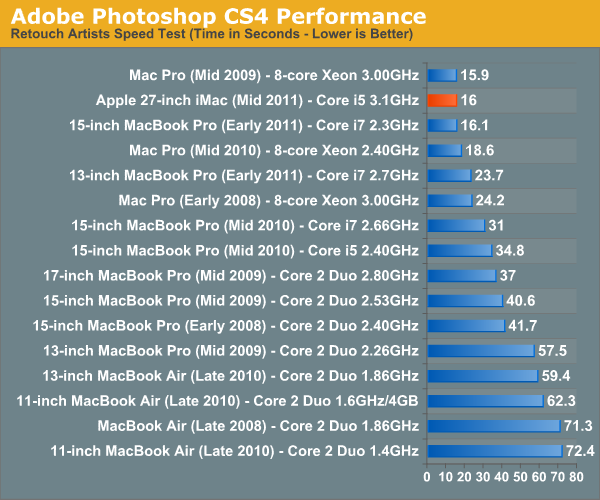
The high-end 27-inch iMac is a very capable Photoshop machine. A hair faster than the new MacBook Pro, the iMac delivers the same performance as an 8-core Mac Pro from 2009 or 2010.
Aperture 2 RAW Import
For my Aperture test I simply timed how long it took to import 203 12MP RAW images into the library.
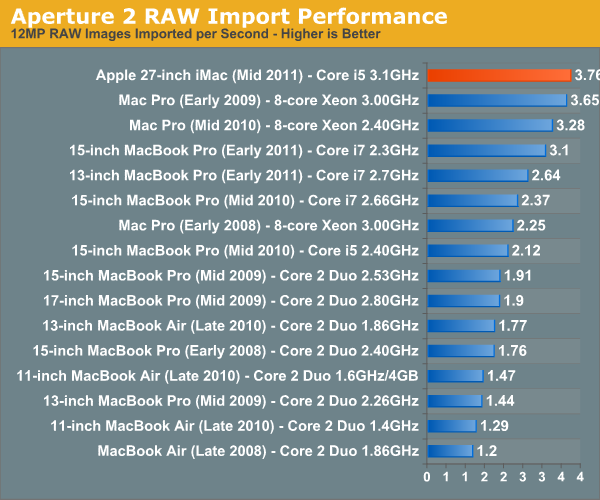
We have a new winner here! The MacBook Pros were always limited by their slower 2.5" hard drive, but the iMac with Sandy Bridge in additional to a speedier disk give us better image import performance than the '09 and '10 Mac Pros. I told you this thing was fast.
Cinebench R10 & 11.5
I’m a fan of the Cinebench tests because they lets me show off both single and multithreaded performance in the same workload. First, the single threaded performance:
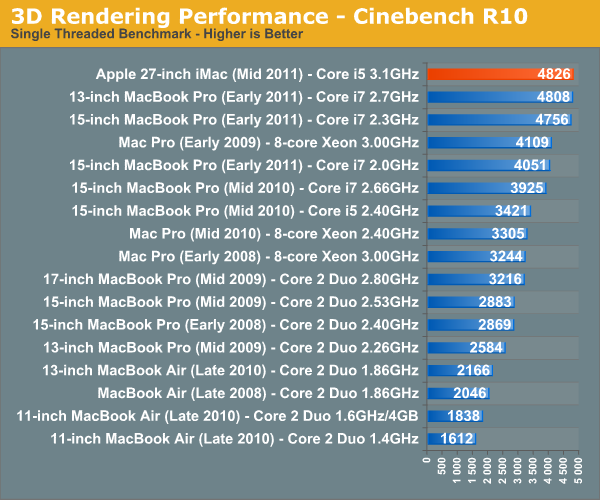
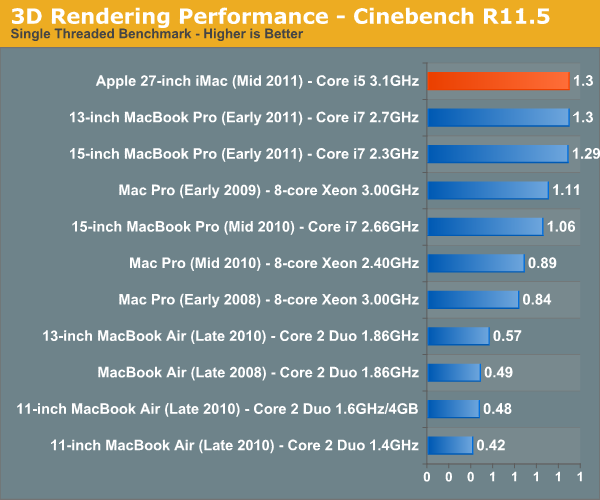
Sandy Bridge quad-core CPUs make no sacrifices. You get excellent single threaded performance which means general OS usage, launching applications and even rendering most web pages happens as fast as physically possible as the other cores are power gated and asleep. Start multitasking however and you'll see the Core i5 in this machine is no slouch:
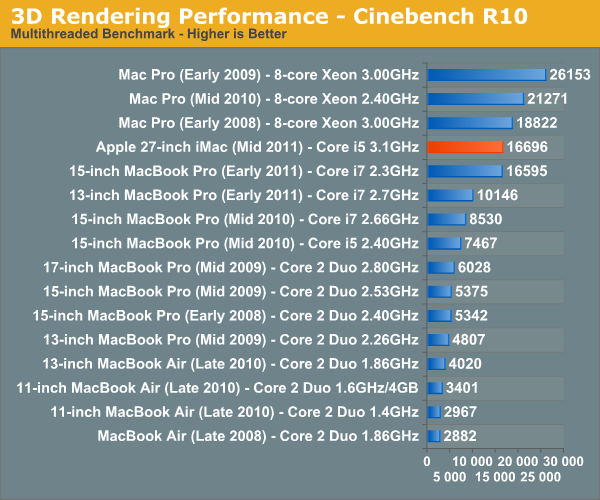
There's still no replacement for more cores when it comes to heavily threaded applications, the past three years of 8-core Mac Pros are still faster than the new 27-inch iMac here. I suspect the upgraded Core i7 would at least let the iMac beat the 2008 Mac Pro thanks to Hyper Threading, but the other two systems are simply out of reach. For those users, you're better off waiting for the Sandy Bridge-E Mac Pro update expected sometime in Q4.
You'll notice in Cinebench R10 the 15-inch MacBook Pro is nipping at the heels of the new iMac. Chalk that up to the larger L3 cache and Hyper Threading, both advantages enjoyed by the MacBook Pro. Look at what those advantages do in Cinebench R11.5's multithreaded test:
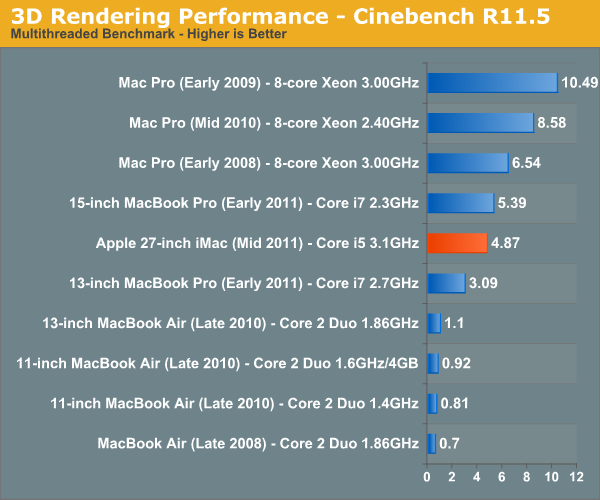
Here the MacBook Pro actually gains on the iMac. More threads and more cache are better suited for the Cinebench workload. If you do a lot of offline 3D rendering and you want the iMac, I'd suggest upgrading to the Core i7-2600 that Apple offers. You get a not insignificant boost in clock speed but more importantly, Intel switches on Hyper Threading which gives you twice as many threads.
Quicktime H.264 Video Encoding
Our final benchmark is more consumer focused. Here I'm taking an XviD and converting it to an iPhone-supported H.264 format.

QuickTime doesn't make tremendous use of all cores all of the time, and thus the MacBook Pro loses its threading advantage. The iMac is our new champion of this test.










139 Comments
View All Comments
tipoo - Friday, May 27, 2011 - link
Nevermind me, it was answered in the article.tipoo - Friday, May 27, 2011 - link
I heard that unlike previous iMacs, the new ones can only use another mac with Thunderbolt to use the iMac as a targeted display. Is that true? I wouldn't feel so bad about discarding such a system when the GPU and CPU feel too old in two or three years like Anand mentioned if I could use it as an external display, but I think the new ones are limited to only being used by other Macs. And that's also assuming Mac's in 3 years will use compatible Thunderbolt ports.TegiriNenashi - Friday, May 27, 2011 - link
What is wrong with this display? Just one number: 16:9.QuietOC - Friday, May 27, 2011 - link
I have used a 20" white iMac and 24" aluminum iMac. The later has a big persistent image problem. Evidently IPS pixels don't work well in a hot environment. The low noise level of the iMac is nice to mostly not hear, but the visual noise might be worse.Also the cheap 320GB WD Caviar failed by randomly disappearing which may have be heat related, and the USB ports have also started randomly disconnecting. The mouse and keyboard just stop working during the day and I have to unplug them and plug them back in. So, no, I would not recommend getting a $1000 monitor with a computer mounted inside it.
KoolAidMan1 - Friday, May 27, 2011 - link
I've owned both the 24" iMac you talk about and a 27" from late 2009. Image persistence became a problem with the 24" models, as well as the CCFL losing some of its brightness by the two year mark.The new 27" models do not have either issue. Image persistence has been fixed, and I don't expect there to be any fading since LED backlights don't suffer from the same degredation issues that CCFL backlit displays do over time. On a related note, I have a NEC 2490WUXi as my secondary display. That monitor uses the same 24" H-IPS panel that the old 24" iMac did. It has minor image retention issues, but not to the same degree as the iMac had. Whatever LG did with their new 27" panels seems to have addressed that problem.
zhill - Friday, May 27, 2011 - link
First off, nice article Anand. Well presented and I think your perspective is a common one in this case. I agree that the lack of upgrade options and rather mediocre gpu performance are certainly off-putting for a machine in this price range, but I also think that your observation that if you are willing to spend $1800 for a laptop with a reasonably short lifecycle then the iMac is not much different. I think you've really hit the point there--the iMac's target customer.I would argue that most iMac users are not highly technical, power users. They are people that want a big screen and don't need the portability of a laptop. These people, like my parents, value the simplicity and ease of use of the iMac and the fact that their workspace is often small and would rather it not be covered in cords and cables. In that case not only does the iMac make sense but it's lifespan is substantially longer and all the GPU they need is enough to drive the system and maybe do some video editing. Gaming prowess has never been an apple concern and I doubt it will be until Steve Jobs decides to buy Activision or EA. I do like the iMac from a compute appliance perspective, just plug it in and compute--no fuss. Also, trying to make a reasonable gaming rig with a 2560x1440 display is a fairly daunting task even with today's cards. You would have to be near the top-end and that's a whole lot of power and heat to dissipate in a reasonably small enclosure (considering the size of a 6970 or 580 card by itself).
I also have to say that Intel's recent willingness to keep switching chip sockets has made upgrades far more painful than they should be (yes, I have a core i7-920 with socket 1366 that is now essentially orphaned).
Alberts - Friday, May 27, 2011 - link
Securedoc for Mac from a company called Winmagic supports SSD's with encryption hardware as long they adhire to the opal specification from the trusted computing groupJimmiG - Friday, May 27, 2011 - link
You can't upgrade the hardware and you can't separate the computer from the display so you can keep using the display long after the hardware has become obsolete.That's pretty much the oposite of "green".
Spazweasel - Friday, May 27, 2011 - link
This may be old news (I'm not going to wade through 6 pages of Apple-hating trolls to see), but you CAN use your 27" iMac as a monitor:http://support.apple.com/kb/HT3924
It's called "Target Display Mode".
KoolAidMan1 - Friday, May 27, 2011 - link
Note that it is only talking about the 2009 and 2010 models with mini-DP ports. Those can take an external source so you can use the 27" iMac as a monitor. I use it every day as the primary monitor for my gaming PC.The new 2011 iMacs have different requirements since they switched to Thunderbolt ports. Until an adapter or something comes out, the only sources that can output a video signal to the 2011 iMacs are Thunderbolt equipped computers. For the time being this only limits them to 2011 Macbook Pros and other iMacs (which would be a weird application).
I love the iMacs, but as someone who uses Target Display Mode every day, the new requirements bother me. It won't be a problem in a year or so when Thunderbolt becomes more common, but for the time being it is pretty limiting.